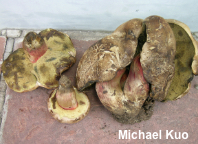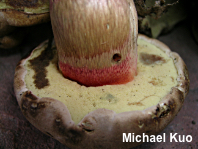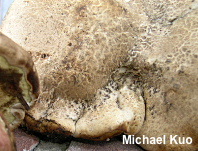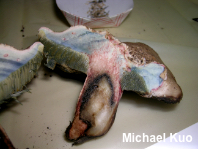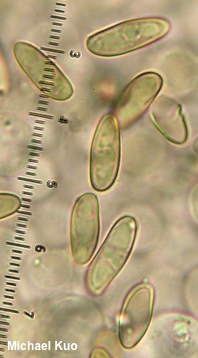| Major Groups > Boletes > Boletus frustosus |

|
Boletus frustosus [ Basidiomycota > Boletales > Boletaceae > Boletus . . . ] by Michael Kuo A western North American bolete with a brown, areolate cap and red reticulation on its stem, Boletus frustosus is a stocky, conifer-associated, montane species found from middle to high elevations. It was originally described from the slopes of Mt. Shasta (Snell & Dick 1941), under fir. Other distinguishing features include its incurved cap margin, which features a tiny sterile overhanging portion, and its bitter taste. Boletus calopus var. frustosus is a synonym—and Boletus frustosus has been called "Boletus calopus" in several North American field guides (the true Caloboletus calopus is a European species). Boletus rubripes is a similar western North American species with a paler cap and a non-reticulate stem. "Caloboletus frustosus" is, putatively, another synonym. However the name was published in a non-peer-reviewed online venue without a shred of scientific support, and while science may eventually support the transfer to Caloboletus, it has not done so yet. See this page for more information on the problem of online nomenclature. "Caloboletus conifericola" may also represent the same species, according to Siegel & Schwarz (2016). Description: Ecology: Mycorrhizal with conifers; growing scattered or gregariously; summer and fall; found in the Sierra Nevada, the Cascades, and the Rocky Mountains at middle to high elevations. The illustrated and described collection is from Colorado. Cap: 7–15 cm; convex, becoming broadly convex; dry; kid-leathery to the touch when young but soon bald; surface cracking up with age so that whitish flesh shows through the cracks; margin inrolled, with a 1–2 mm overhanging sterile portion; medium to dark yellowish brown. Pore Surface: Dull yellow at first, becoming olive; bruising blue promptly, then staining brown where bruised; 3–4 pores per mm; tubes to 2 cm deep. Stem: 5–10 cm long; 2.5–3.5 cm thick; equal above an abruptly tapered base; ground color brownish, but sometimes developing red areas and streaks; finely reticulate with a red reticulum; basal mycelium whitish. Flesh: Whitish to very pale yellowish; quickly staining red in the stem and pale blue in the cap when sliced. Odor and Taste: Odor not distinctive; taste bitter. Chemical Reactions: Ammonia negative on cap surface and flesh. KOH on reddish brown on cap surface; orangish on flesh. Iron salts grayish on cap surface; negative on flesh. Spore Print: Olive brown. Microscopic Features: Spores 11–14 (–17) x 4–5 µm; boletoid-fusiform; smooth; yellowish in KOH. Basidia 4-sterigmate. Hymenial cystidia scattered and infrequent; up to 40 x 7.5 µm; fusiform; smooth; thin-walled; hyaline in KOH. Pileipellis a cutis. Contextual hyphae inamyloid. REFERENCES: Snell & E. A. Dick, 1941. (Singer, 1947; Smith, 1975; Smith, Smith & Weber, 1981; Arora, 1986; Both, 1993; Bessette et al., 2002; Miller & Miller, 2006; Desjardin, Wood & Stevens, 2015; Seigel & Schwarz, 2016.) Herb. Kuo 08171410 (= Herb. DBG F-028332). This site contains no information about the edibility or toxicity of mushrooms. |
© MushroomExpert.Com |
|
Cite this page as: Kuo, M. (2020, August). Boletus frustosus. Retrieved from the MushroomExpert.Com Web site: http://www.mushroomexpert.com/Boletus_frustosus.html |
